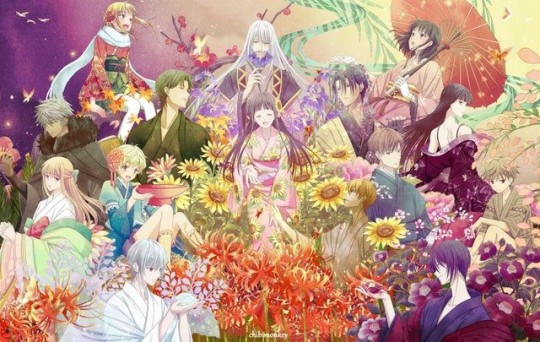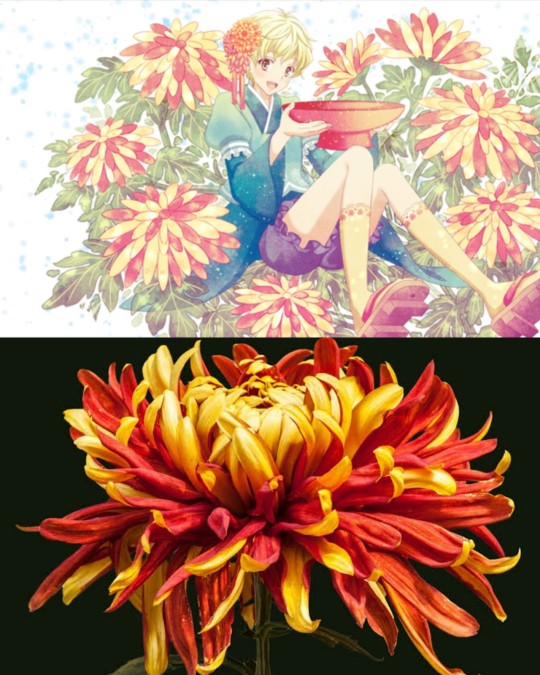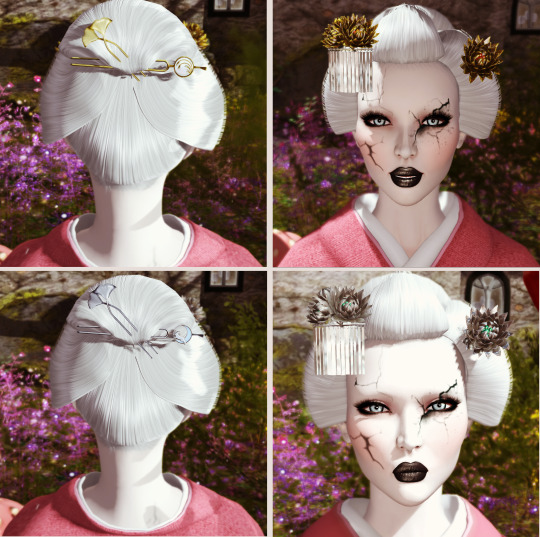#susuki kanzashi
Explore tagged Tumblr posts
Note
Favorite and least favorite months for kanzashi? 👀💜 Personally, my favorites are maneki in December, yanagi in June, and susuki in August. My least favorites are kiku in October, nanohana in March, and kangiku in January.
I love me some wisteria in May, morning glories in August, and chrysanthemums in October. Not totally a fan of plum blossoms in February, nanohana in March, and round fans in July ^^;
7 notes
·
View notes
Photo

August 9th, 2020: Maiko Ichihiro (市紘) of Nakagishi okiya in Gion Kobu dances with two fans. She is wearing the usual silver pampas grass kanzashi for August as well an iconic fireworks kimono.
Source: 55maiko's facebook Photo By: Hiromu Aoki
83 notes
·
View notes
Photo

Tsumami Kanzashi Challenge Day 12 - Pampass grass I got stuck with this one - though pampas grass is one of my fav motifs, I couldn't wrap my head around it. I wanted to try something new as I've done susuki in many ways in the past. This came up... Oups. I will do better tomorrow ^^' #tsumamizaiku #tsumamikanzashi #tsumamizaikumonth #challenge #artober #craftober #octoberchallenge #october #handmade #challenge #つまみ細工 #月の挑戦 #kimono #craft #kanzashi #silk #Japan #susuki #pampasgrass (w: Warsaw, Poland) https://www.instagram.com/p/CGUU0BZA2AG/?igshid=uukueewmlxld
#tsumamizaiku#tsumamikanzashi#tsumamizaikumonth#challenge#artober#craftober#octoberchallenge#october#handmade#つまみ細工#月の挑戦#kimono#craft#kanzashi#silk#japan#susuki#pampasgrass
7 notes
·
View notes
Text
💐Hanakotoba in EDEN ~Fruits Basket 2nd Season ED 2 💐
~Part 2~

⚠️NOTE: THIS POST MAY CONTAIN SPOILERS FOR THE LAST SEASON OF THE ANIME!⚠️
Ritsu Sohma
薄 | Susuki | Pampas Grass

Pampas grass is a symbol of Autumn—the harvest season and is used as a symbolic replacement for rice in the offerings at the Harvest Moon Festival. This autumn symbolism correlates with Ritsu's zodiac month.
Momiji Sohma
菊 | Giku | Chrysanthemum

Red and Orange chrysanthemums represent cheerfulness, friendliness happiness all of which correlate with Momoji's upbeat and kind personality. However in some cultures yellow chrysanthemums can symbolize rejected love—which correlates with Momoji being rejected by his mother and thus being forced to live separately from his family. This steep juxtaposition caused by the double meaning could be a nudge to hope Momoji hides his loneliness and longing from others behind a cheerful exterior.
Shigure Sohma
楓 | Kaede |Japanese Maple Tree

Japanese maple tress have been associated with grace and serenity. These attributes compliment Shigure's lax personality. The tree is said to posses a sense of elegance and taste a nod to Shigure's sense of style and career. Maple trees can represent persistence and patience—two inherent qualities of Shigures shown as he patiently waits for the curse to be broken and his schemes to fall in place.
Kagura Sohma
柳 | Yanagi | Willow tree

Willow trees represent sadness and freedom. Neither of which really suit Kagura. They look cool though...
Edit: In light of me finally finsihing and then rewatching the series recently I realized that in a way the willow tree's meaning does suit Kagura. Spoilers ahead: By the end of the series she has "freed" herself of her one-sided love for Kyo which was founded on pity and gave her a sense of purpose and drive in life. Now having been freed of that sense of purpose she is left with a sense of emptiness. While she is undoubtably happy for Kyo—she herself is left alone and sad. However, free of the curse she now has the opportunity to love whomever she chooses and do whatever she wants with her life—since she is no longer bound to anyone and is no longer bound by anything.
Yuki Sohma
桐 | Kiri |Paulownia

Paulownia trees were traditionally planted when Japanese couples have a daughter and as such have come to represent purity and femininity—a possible nod to Yuki's feminine appearance. Its meaning of purity fits in how others in the show view him. At school he is seen as a "prince" as he is seemingly untouchable, perfect and kind. However in reality he is akward, lonely and introspective. In his hands Yuki holds a white rose—a symbol of purity—and faces towards the right juxtaposing him against Akiot in the next panel who is facing left holding out a red camelia with a blood-stained hand.
Akito Sohma
赤椿 | Aka Tsubaki | Red Camelia

Red camelias are said to symbolize being in love, perishing with grace, devotion, deep desire and nobility—the latter of which a reference to Akito's status as god of the current zodiac generation. Akito believes that she was born to be loved and that the members of the zodiac should be wholly devoted to her. This can also represent her deep desire to be loved considering the lack of parental love received during her childhood.
During a flashback scene shown in season three Shigure gives Akito a red camelia—a symbol of his love, desire and devotion. He later gifts her a kanzashi and kimono patterned with the same flower. The dark and intense colour palette as well as Akito's blood stained hands in this panel contrast greatly with the previous panel of Yuki which has a softer colour palette.
Tohru Honda
向日葵 | Himawari | Sunflower

Sunflowers represent cheerfulness, optimism, passionate love and radiance—all of which describe Tohru's personality perfectly. Sunflower heads turn to face the sun directly and all the flowers pictured in the panel are facing towards Tohru who is bathed in light. This protrays how Tohru's presence is like the sun for the zodiac members—bringing light, positivity and hope from them despite their tough circumstances. Tohru reaches out her hand and smiles. It can be theorizing that this panel links to the forst panel of Kyo therefore surmising that the light Kyo is reaching for is Tohru and likewise Tohru is extending her hand towards Kyo. In other words Tohru's love is the light in Kyo's life freeing him from his dark circumstances. Her acceptance of him saves him from the dark fate suffered by previous cat zodiac hosts.
[Important! Find Part 1 here!]
[If you liked this post check out my other hanakotoba analysis posts here ❀]
#fruits basket#fruits basket 2019#fruits basket second season#fruits basket season 2#hanakotoba#anime ending#tohru honda#kyo sohma#yuki sohma#yuki souma#ritsu sohma#shigure sohma#akito sohma#kagura sohma#momoji sohma#sohma family#kyo x tohru
380 notes
·
View notes
Photo


Tokyo style vs Kyoto style… While browsing the web for pictures of Mukojima Hangyoku, I came across these from the Dojoji Ryotei’s blog. They were taken in August 2013. Here, you can see Hangyoku Tomo 友 from Mukojima, Maiko Eriha 恵里葉 (1st picture)/Chiyoko 知余子 (2nd picture) from Gion Kobu and Geisha Kiyoki 清貴. All three of the Maiko went on to become Geisha/Geiko. Chiyoko retired in 2018, Tomo changed her name to "Tomoka" 朋加 upon Erikae and retired in 2020. Eriha is still a Geiko as of 2023.
If you look closely, you can spot many differences in the style of both girls: Tomo’s Furisode and Eriha’s Hikizuri. Tomo wears Uchiwa (round fan) Kanzashi, which Kyoto Maiko do in July, not August. Eriha wears Susuki (pampas grass) Kanzashi, which isn’t observed in Mukojima. Tomo doesn’t wear an Obidome, which is an essential part of a Kyoto Maiko’s outfit.
69 notes
·
View notes
Photo

Senior Maiko Fukusuke with Susuki Kanzashi 1930s. Senior maiko (apprentice geisha) Fukusuke of the Gion Kobu geisha district in Kyoto, wearing a susuki (Japanese pamas grass) hana kanzashi (flower hairpin) for the month of August. Her nearly all white han-eri (decorative inside collar) shows that she is a senior maiko, about to become a geiko (geisha). Silver coloured susuki is worn by senior maiko, while junior maiko wear pinkish-silver susuki. Text and image via Blue Ruin 1 on Flickr
101 notes
·
View notes
Photo

It's almost time for Hassuaku! On first of August geiko and maiko go around places of business to thank for their continuous patronage. They wear gorgeous summer weave kuromontsuki hikizuri and adorn their hair with August kanzashi such as susuki (pampas grass), asagao (morning glory) or kingyo (goldfish). I made myself an iridescent susuki version back in 2013 or 2014, but since then I improved my technique greatly and I feel like the old kanzashi is a bit shabby to wear now, so I decided to update my design. This time I went for aqua organza as opposed to white/see-through because I feel it would fit better for my August kimono ensembles and also because it's a bit different from the standard colours! 😁 #八朔 #kanzashi #KanzashiYume #つまみ細工 #かんざし #Japan #髪飾り #手作り #日本つまみ細工コンテスト #ハンドメイド #コサージュ #канзаши #伝統工芸 #日本文化 #手芸 #舞妓 #和小物 #趣味 #hobby #headdress https://www.instagram.com/p/B0jrJbPIbpm/?igshid=ec5qln56fdgq
#八朔#kanzashi#kanzashiyume#つまみ細工#かんざし#japan#髪飾り#手作り#日本つまみ細工コンテスト#ハンドメイド#コサージュ#канзаши#伝統工芸#日本文化#手芸#舞妓#和小物#趣味#hobby#headdress
11 notes
·
View notes
Photo

kisetsu - Autumn Kanzashi Gacha
I wear:
Autumn Kanzashi Gacha - Ginko - Gold / Silver
Autumn Kanzashi Gacha - Kiku Bira - Gold RARE / Silver RARE
Autumn Kanzashi Gacha - Kiku Hana - Silver RARE / Gold RARE
Autumn Kanzashi Gacha - Usagi - Silver
Autumn Kanzashi Gacha - Susuki - Gold
There also is:
Autumn Kanzashi Gacha - Tama Type 1 / Tama Type 2 - Gold / Silver
#kisetsu#hair decoration#maiko#geisha#broken doll#usagi#kick hana#gacha#autumn kanzashi#silver jewelry#Tama#second life
1 note
·
View note
Photo

▿Credits ▿ Hair: VCO HAIR _ Bibi [Blonde] - resizer NEW@epiphany Earring: ALTAIR* sweetheart earrings NEW@epiphany Hair accessory: kisetsu - Hana Kanzashi - Susuki - Red Backing kisetsu - Small Kanzashi - Uchiwa (Susuki set) - Red Gem Choker: ALTAIR* shoujo spy choker .red. NEW@epiphany *::.who what.::* -Acorn Ribbon choker- TSS 3th Wing: *N*Rose Wing #red Eyepatch:*{( konpeitou )}* Yami-Neko 9 : yosomi --------------------------------------------------------------------- Clothes:NEW@epiphany ALTAIR* shoujo spy garter .albino. ALTAIR* shoujo spy RARE B ALTAIR* shoujo spy sleeves .albino.
7 notes
·
View notes
Photo

August 2015: maiko Mamefuji dressed formally for Hassaku surrounded by her sister maiko.
If you know the source please tell me so I can credit!!!
#geisha#maiko#mamefuji#hassaku#hassaku 2015#august#susuki kanzashi#special hikizuri#tama okiya#gion kobu
14 notes
·
View notes
Text
Kanzashi of The Month: August - Pampas Grass
I’ve been waiting for Kazurasei to finally upload an image with just this motif, and they finally did a few days ago! It’ll become clear soon as to why I wanted to show this motif alone. As always, all kanzashi are from Kazurasei.

Image courtesy of Kazurasei. Susuki (薄) - Pampas Grass One of the only summer motifs that stays strictly within the month it represents, pampas grass is a unique and stand out motif! For starters, it’s one of the only monthly kanzashi motifs that does not depict any flowers. Yes, it has a very shiny center that is filled with rhinestones, but those are there for a separate reason: pampas grass has fluffy, silvery-pink tufts in real life and looks absolutely dazzling when it catches the sun’s rays, especially when covered in dew. The rhinestones are present to show that concentrated reflection. Like the center, the outside “petals” are also made from very reflective and iridescent fabric, with more traditional designs featuring silver paper! As is apparent by this point, it does not feature the usual tsumami (pinched silk) techniques that non-summer motifs often do and cannot be found in alternate tsumami form like some of the others have.

Image courtesy of Kazurasei. Being a grass, it can also grow pretty much anywhere, with entire fields being filled with the ethereal plant. You can buy and grow your own from almost any nursery nearby as they’re quite hardy and easy to take care of (side note: the Japanese pampas grass is actually considered a dangerous invasive species in California, so please make sure that you take proper care of the plant and do not toss it into the wild). The second image shows a bit more of where the pampas grass can grow and why its known for its sparkle. As you may have surmised from the inclusion of dew and now dragonflies (hint: the next motif), pampas grass can be found growing wild along the shores of rivers and ponds. Their silvery tips reflect the water and provide a stunning display with the dragonflies that mate during this time who are as iridescent as the grass, which makes the combination seems almost magical!

Image courtesy of Maiko Club/Geisha Japan. When being worn the kanzashi seems completely different as its blue shine brings to mind cool rivers and its spread “petals” like those of fireworks. Like with Ryōka (涼香) of Sakaemasa (栄政) in Gion Higashi (above), you can’t help but stop and stare when a maiko wears this kanzashi! Whether in one large burst or smaller bursts (like the example with the dragonflies) it’s extremely popular with maiko of all ranks for its sparkle and shine!
124 notes
·
View notes
Text
hassaku is in 2 days

#blog words#karyukai is love#i fukken love hassaku ok#bring on the susuki kanzashi and the gion kobu kuromontsuki
4 notes
·
View notes
Note
What are the translucent susuki kanzashi made of? Some look metallic but specifically the translucent ones?
They are made from silk ^^
8 notes
·
View notes
Photo

Uchiwa fans are mostly summer accessories and adorable tourist souvenirs, but kanzashi also use this motif in summer, mostly July kanzashi. Those kanzashi can be clusters of simple fan with popular summer motifs, like dragonflies, susuki grass or willow. One of my personal favourites is kingyo, or goldfish. A distant relative to koi, ornamental carp, kingyo used to be associated with wealth and abundance. In Japan kingyo are mostly associated with a game called “kingyo sukui”, where participants try to fish out goldfish from large tanks using paper scoopers. They are much more than just starter pets for kids, though. They can live up to 20 years and are quite smart. We use the term “goldfish memory” as a way of suggesting forgetfulness, but it’s utterly inaccurate as rather than a few seconds, a goldfish can remember facts up to 5 months. So have the memory of a goldfish :) #goldfish #kingyo #kanzashi #uchiwa #japanesefan (w: Warsaw, Poland) https://www.instagram.com/p/CE3XDwjgxSH/?igshid=3mvvy0jyqsje
13 notes
·
View notes
Photo

I am currently obsessed with miniature pendants. Bear with me :) This is a classic bellflowe and susuki grass pairing but the bellflower is inspired by those painted on laquer kanzashi ♡ (w: Warsaw, Poland) https://www.instagram.com/p/CG2EtU0APp3/?igshid=1wyu5xkaceues
5 notes
·
View notes
Photo

Tsukimi (月見) literally meaning, "moon-viewing", is a Japanese festival honouring the autumn moon. The celebration of the full moon typically takes place on the 15th day of the eighth month of the traditional Japanese calendar; the waxing moon is celebrated on the 13th day of the ninth month. These days normally fall in September and October of the modern solar calendar. Festivals dedicated to the moon have a long history in Japan. Aristocrats during the Heian period; influenced by the Chinese custom of Mid-Autumn Festival, they would gather to recite poetry under the full moon, or hold moon-viewing events aboard boats in order to view the moon's reflection on the surface of the water. Tsukimi traditions include displaying decorations made from Japanese pampas grass (susuki) and eating rice dumplings called Tsukimi dango to celebrate the beauty of the moon. In 2020 if falls on 1st October, but rabbit, susuki grass and full moon are very Septeber motifs too, often displayed on maiko kanzashi (also, I was impatient!) #september #tsukimi #usagi #moon (w: Warsaw, Poland) https://www.instagram.com/p/CElVBSYg_YM/?igshid=azhkarr0hii2
8 notes
·
View notes